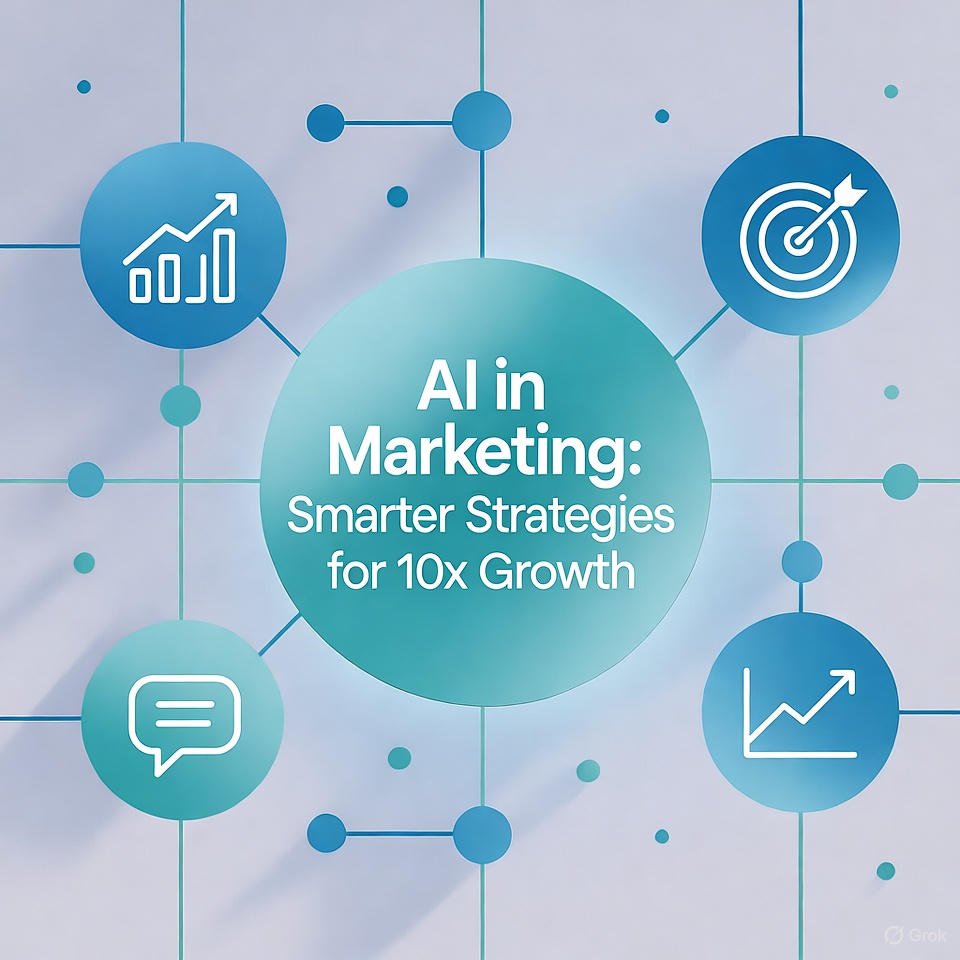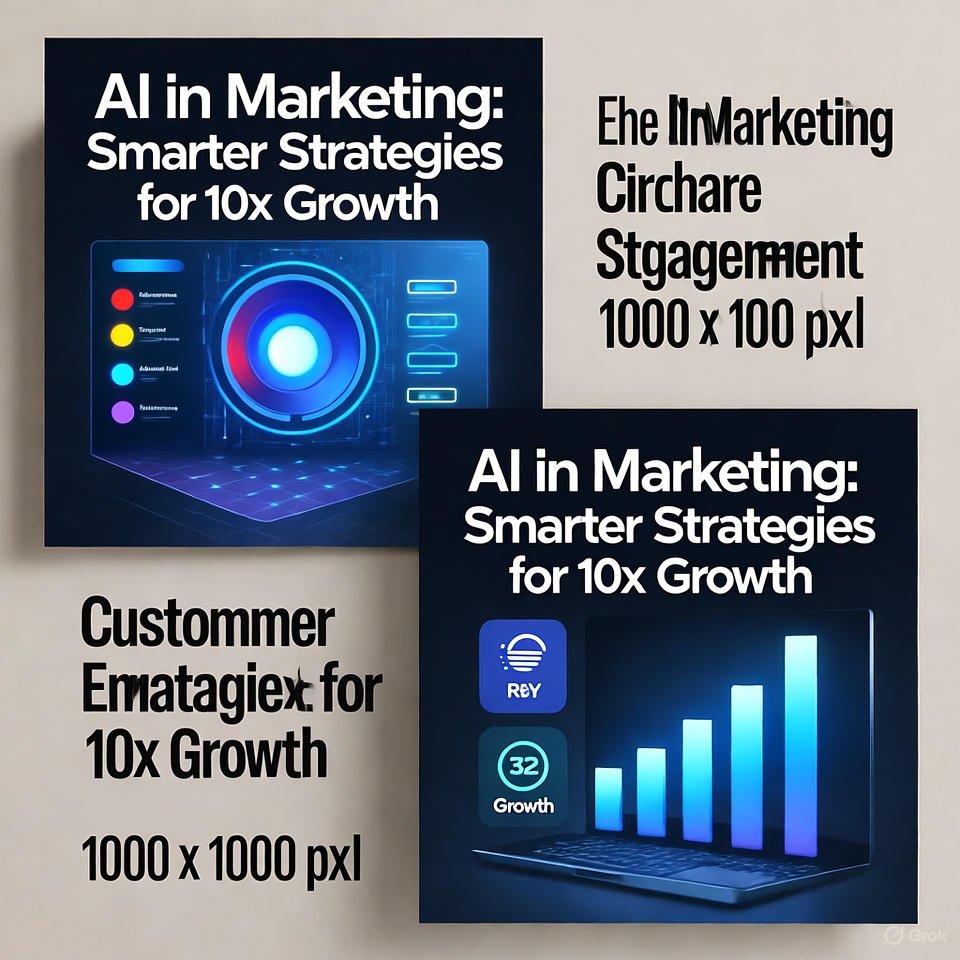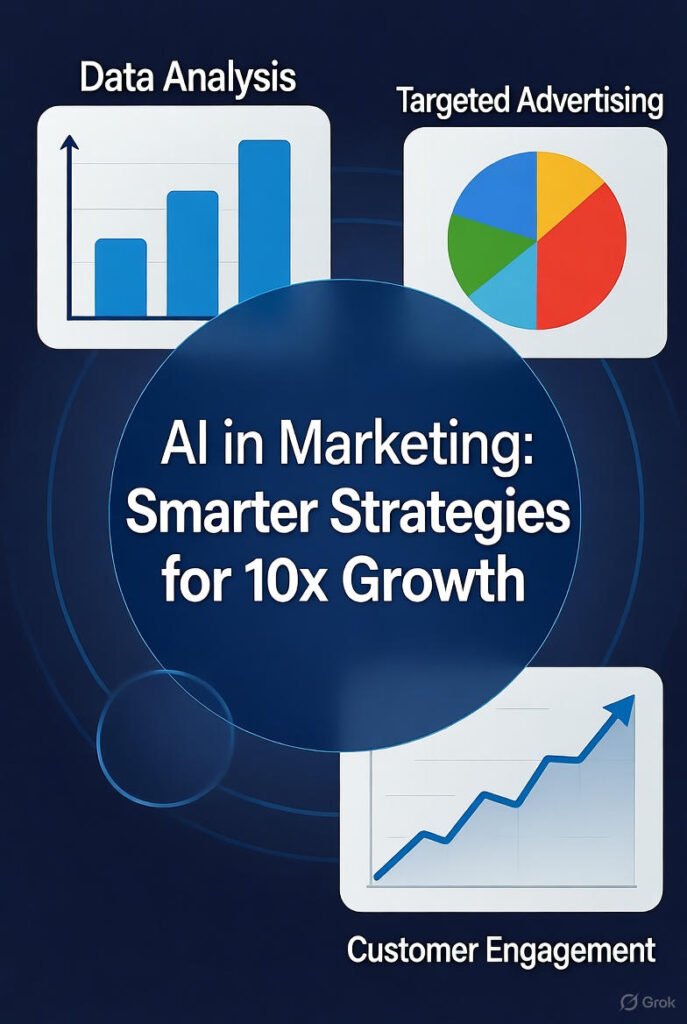
Introduction
Imagine growing your marketing ROI tenfold—not by spending ten times more, but by working smarter. That’s the promise (and reality) many companies are already seeing by weaving AI intoAwareness of these risks helps ensure their marketing strategies.
Artificial Intelligence is no longer a buzzword reserved for tech giants. It’s becoming an essential tool for marketers who want to cut through noise, deliver highly relevant content, and measure what works in real time. In fact, according to one report, organizations investing deeply in AI see a 10–20 % boost in sales ROI from marketing and sales integrations.
In this post, we’ll unpack how you can leverage AI in marketing—step by step—to scale faster, with smarter strategies that are rooted in data and creativity. We’ll explore use cases, best practices, pitfalls, and real-world examples to help you craft AI-powered marketing that grows your business sustainably.
Let’s dive in.
Why AI in Marketing? The Strategic Case
Before we roll up our sleeves, it’s worth anchoring why AI deserves a place in your marketing toolkit:
Unpacking the ROI potential
- Companies using AI for ad optimization report an average 22% increase in marketing ROI on campaigns.
- Leaders that deeply integrate AI can achieve 1.5× higher revenue growth over peers.
- In direct mail campaigns, machine-learning enhancements delivered a 3–5 % uplift in response rate for Epsilon clients.
These aren’t trivial gains—they compound over multiple campaigns, channels, and customer touchpoints.
Competitive necessity & adoption trends
- The AI in marketing market is currently valued at $47.32 billion (2025) and projected to grow at a CAGR of 36.6 % through 2028.
- Surveys show 88 % of marketers now use AI in day-to-day workflows.
- In a recent study, 93 % of CMOs say generative AI is already delivering measurable ROI.
In short: the bar is rising. If your competitors adopt AI faster and more thoughtfully, they may outpace you in efficiency, audience targeting, and agility.
How AI Powers Marketing: Core Use Cases
AI isn’t a magic wand, but it is a versatile engine you can plug into multiple parts of your marketing flywheel. Below are key pillars and tactics:
1. Smart Content Generation & Optimization
- Generative copy & visuals: Use models like GPT or diffusion-based image AI to create drafts—then refine them with human oversight.
- Dynamic content adaptation: Tailor messaging, CTAs, images based on user segments in real time.
- SEO & keyword optimization: Have AI suggest relevant keywords, meta descriptions, or internal linking structures.
Tip: Always treat AI output as a first draft—not final. You add brand tone, nuance, and emotional resonance.
2. Predictive Analytics & Customer Segmentation
- Segment audiences based on behavioral signals (e.g. browsing, cart activity) using clustering and classification models.
- Use predictive churn, upsell, and lifetime value (LTV) models to focus resources where they’ll deliver the most return.
- Fine-tune offers using contrastive learning—e.g. a recent model “SLM4Offer” improved offer acceptance by ~17 % via personalized offer generation.
3. Automation & Workflow Acceleration
- Email drip sequences & follow-ups: Trigger intelligent messaging automatically based on user actions.
- Ad scheduling & budget pacing: Let AI reallocate ad budgets dynamically across channels to optimize cost-per-acquisition (CPA).
- Lead scoring and qualification: Prioritize leads for sales teams using AI scoring, freeing humans to focus on high-value interactions.
A standout example: AI sales agents helped the Waiver Group book 25% more consultations within just weeks.
4. Real-time Personalization & Recommendations
- On-site product recommendation engines (think Amazon) that adapt as users browse.
- Personalized promotional offers, upsells, or cross-sells based on user persona and behavior.
- Email content that varies per segment or individual, not just send-time, but subject lines, visuals, and messaging.
Starbucks, for instance, uses predictive analytics in their app to suggest what a user might order next based on past visits and context.
5. A/B Testing & Multivariate Experiments at Scale
- Rather than test two versions, AI can run hundreds or thousands of permutations (headlines, images, colors) to find optimal combinations.
- Tools like Evolv AI helped Euroflorist increase conversion rates by 4.3 %, with a 220 % ROI in a year.

6. Chatbots, Conversational AI & Virtual Assistants
- Smart bots can answer FAQs, triage leads, schedule demos, and gather data 24/7.
- They also collect conversational insights—what customers ask, how they respond—feeding data into other systems.
When done well, they free up substantial human bandwidth and can even reduce friction in the funnel.
Building Your 10× Growth AI Marketing Strategy
To harness AI successfully, you need more than cool tools—you need strategy, discipline, and alignment. Here’s a roadmap:
Step 1. Define clear objectives & KPIs
Start with concrete goals—e.g. increase MQL-to-SQL conversion by 30 %, lower cost per lead by 20 %, or boost repeat purchases by 2×.
Map AI interventions to those metrics.
Step 2. Audit your data infrastructure & readiness
AI is only as good as your data. Ask:
- Do you have customer-level event tracking?
- Is your CRM integrated and clean?
- Can you join data across touchpoints—web, email, ads, offline?
If your data is siloed, fix that before layering AI solutions.
Step 3. Prioritize use cases by impact & feasibility
Use a matrix: effort (low to high) vs. expected ROI (low to high). Some early “quick wins” might include:
- Email subject line optimization
- Lead-scoring models
- Creative A/B variant testing
Don’t attempt the full stack from day one—prove value early, then scale.
Step 4. Choose tools—and integrate into stack
Look for AI capabilities compatible with your MarTech suite (CRM, marketing automation, analytics). Some options:
- Generative AI platforms (OpenAI, Anthropic, etc.)
- AI-driven ad optimization tools
- Recommendation engines (Retino, Dynamic Yield, etc.)
- Automated email personalization tools (e.g. Seventh Sense)
Aim for modular integration rather than monolithic bundles.
Step 5. Establish guardrails, review loops & human oversight
- Review AI-generated content for brand compliance, accuracy, and tone.
- Monitor performance drift—AI models degrade over time if not retrained.
- Set thresholds where human intervention kicks in (e.g. unusual campaign performance).
Step 6. Test, learn, and optimize continuously
- Use experimentation (A/B, multi-armed bandits) to compare AI vs. non-AI approaches.
- Track metrics at macro (revenue, ROI) and micro (open rates, click-through, bounce).
- Rotate features, refine models, and archive unproductive campaigns.
Step 7. Scale horizontally and vertically
Once one channel (email, ads, website) shows success, replicate across others.
Scale vertically: increase coverage (more segments, more offers), deepen personalization (micro-moments, context awareness).
Real-World Examples & Lessons Learned
Let’s bring theory to life with some standout AI marketing use cases:
Case Study 1: Hatch / Google Gemini (Ads Optimization)
Using Gemini, Hatch ran a campaign that achieved:
- 80 % higher click-through rate
- 46 % more engaged site visitors
- 31 % better cost-per-purchase vs. traditional campaigns
- Campaign creation time halved; cost down ~97 %
Lesson: AI can turbocharge creativity and efficiency when the targeting data is strong.
Case Study 2: Klarna (Generative AI in Marketing Pipelines)
Klarna used generative AI for image creation, campaign iteration, and marketing automation:
- Saved ~$10M annually
- Reduced image production costs by ~$6M
- Shortened image timeline from six weeks to seven days
- Created over 1,000 images in first quarter
Lesson: Generative AI becomes highly cost-effective when workflows are repeated and scalable (e.g. seasonal campaigns).
Case Study 3: Euroflorist + Evolv AI
Euroflorist used AI-powered multivariate testing to tweak page designs, yielding:
- 4.3 % increase in conversions
- 15 % boost in session duration
- 220 % ROI in the first year
Lesson: Even modest gains in conversion optimization scale dramatically when applied across high-traffic funnels.

Case Study 4: AI Sales Agents in Lead Generation
Multiple companies deployed AI agents:
- Waiver Group added 25 % more consults
- AI lead scoring increased conversions up to 47 %
- Automated early funnel tasks freed sales teams to focus on high-touch interactions
Lesson: AI works especially well in high-volume, repetitive touchpoints where human scaling is costly.
Common Pitfalls & How to Avoid Them
To jump from novelty to impact, you must navigate challenges. Here are pitfalls and fixes:
| Pitfall | Why It’s a Problem | Mitigation |
|---|---|---|
| Data silos & poor quality | Inconsistent or incomplete data produces flawed model predictions | Invest in unified data pipelines, clean data, and event tracking |
| Overreliance without oversight | AI hallucinations or tone mismatches may damage your brand | Always human–review critical outputs; set thresholds for intervention |
| Lack of strategic alignment | AI projects that aren’t tied to business goals waste budgets | Define KPI mapping before implementation |
| Ignoring model decay | AI performance degrades over time as behavior changes | Retrain models regularly; monitor drift and retrench stale features |
| Tool fragmentation | Multiple disjointed tools lead to complexity and maintenance burden | Favor platforms or modular tools that integrate well with your tech stack |
| Unethical or intrusive personalization | Over-personalization can backfire (e.g. “creepy” recommendations) | Use transparency, user consent, and guardrails on extremes |
Five Tactical Ideas You Can Try This Week
To put theory into motion, here are five tactical ideas you can prototype quickly:
- Auto-optimize email subject lines
Feed past subject line data into GPT or another model and generate new variants. A/B test them. - Implement dynamic promo banners
Show offers changing by segment (e.g. first-time visitor, returning), using an AI prediction engine. - Deploy a lead scoring model
Use features like time on site, page views, content downloads to score and prioritize leads. - Create micro-personalization blocks in newsletters
Personalize sections (e.g. “Recommended for you”) using browsing or purchase history. - Run multivariate creative experiments
Use AI to generate multiple variations (headlines, images, CTAs) and test them in parallel.
By isolating one channel or one test, you can demonstrate an early win while limiting cost and risk.
Measuring Success: What Metrics Matter
To know whether AI is delivering 10× growth, you need both guess and verify. Here are key metrics to monitor:
- Top-line KPIs: Total revenue contribution, ROI on AI-powered campaigns, uplift vs. baseline
- Conversion funnel metrics: Visit-to-MQL, MQL-to-SQL, SQL-to-closed, drop-off points
- Engagement metrics: CTR, time-on-page, session duration, bounce rate
- Efficiency metrics: Cost per lead (CPL), cost per acquisition (CPA), time saved
- Model-level metrics: Precision, recall, AUC, model drift indicators
- Content metrics: Open rates, subject-line lift, unique click variation
Always compare to a non-AI baseline. AI should not just generate more volume, but better volume (higher quality, higher ROI).
Looking Ahead: What’s Next in AI + Marketing
The AI tools of tomorrow promise to be even more immersive, contextual, and autonomous. Here’s what’s on the horizon:
- Tiny and domain-specific models: On-device personalization (e.g. customer apps)
- Synthetic data & digital twins: Running AI-driven “what-if” simulations for marketing strategies
- Causality-aware models: Not just correlation, but systems that learn “if I do this, then that”
- AI-native creative systems: Automated video, voice, experiential content generation
- Ethical AI & explainability: Transparent decisioning, bias detection, and trust mechanisms
Brands that experiment now will gain a knowledge edge when these become default.